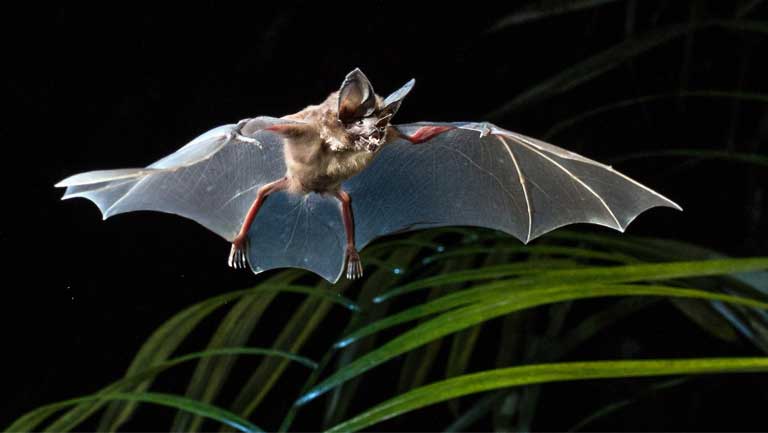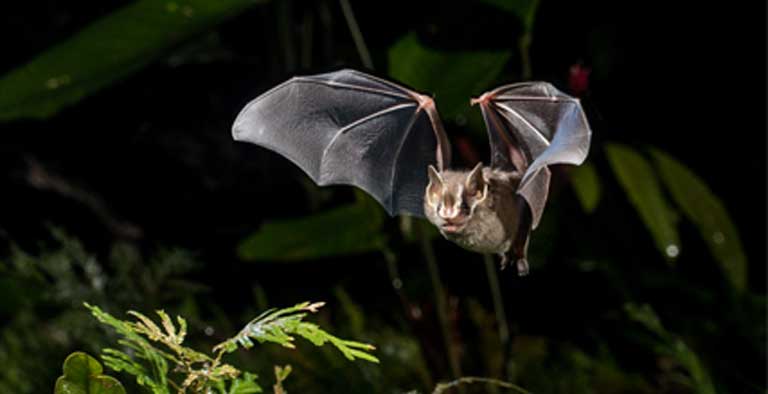- Often small and flying at night, the more than 160 bat species found in the Amazon can be challenging to identify in the field by researchers and amateur enthusiasts.
- To make identification easier, a free, open-access, interactive, downloadable, digital Field Guide to Amazonian Bats — designed for use with tablets or smartphones — has just been published by the National Institute of Amazonian Research.
- The dynamic digital format allows the guide to be continuously updated as new research data becomes available, making the format particularly suited to less explored regions of the world where the rate of new species discovery is high.
- The Amazon bat field guide is to be followed by digital bat guides for Madagascar and East Africa.

More than 160 bat species can be found flying through the Amazonian night — and their variety is astonishing. From the largest (the carnivorous Spectral, or False Vampire bat; Vampyrum spectrum, with a wingspan of over two feet), to small insectivores (weighing just a fraction of an ounce), bats fill a myriad of ecological niches in the rainforest.
But their nocturnal lives make them hard to study, and, with as many as 100 species inhabiting some locales, identifying them in the field poses a huge challenge. Now, an international team of bat researchers hopes to make distinguishing these many species easier with the publication of a new, open-access Field Guide to Amazonian Bats.
The free guide, published by the National Institute of Amazonian Research, is available to download in an interactive, digital format. Designed to be used on tablets or smartphones, clickable links connect content between different sections of the guide, and to IUCN Red List online resources for each species.

The guide is richly illustrated, and is also the first to include echolocation spectrogram patterns for most species. Many bat species hunt or forage high in the canopy, making them difficult to catch, so acoustic monitoring is frequently employed in biodiversity surveys.
“First and foremost, we hope that this guide will help the work of students, practitioners and policy makers and bring visibility to bats which suffer from so much bad publicity,” said Ricardo Rocha, one of the guide’s authors, and a PhD student at the University of Lisbon, Portugal. The poor reputation of bats endures, he added, “despite them being some of our biggest allies in the fight against disease outbreaks and food security. Bats consume mosquitos, which are the main vectors of several important diseases, and [they also eat] agricultural insect pests of crops as important as rice and maize.”
While people can directly benefit from the services bats provide, their importance within ecosystems extends much further than disease and pest control. Acting as predator, prey, seed disperser and pollinator, “[b]ats are key elements in the Amazon’s intricate ecological networks and, through countless links to other animal and plant groups, help support and sustain the biome in all its complexity and magnificence,” the authors write in the guide’s introduction.


The “digital dynamic format” will allow the guide to “be continuously updated as more information comes out,” lead author Adrià López-Baucells said. “We consider this might be the future for field guides for the most unexplored regions in the world… the rate of discovery is so high that static guides easily become obsolete.”
For López-Baucells, also a PhD student at the University of Lisbon, bats have been a life-long fascination, and he describes the almost three years of fieldwork that went into researching the guide as an “unforgettable experience.”

Based at a field station of the long-term Biological Dynamics of Forest Fragments Project in Brazil, the team caught bats in mist-nets — large vertical nets of very fine mesh that are hard to see and echolocate — before carefully extracting the animals in order to take measurements and photographs for the guide.
Acoustic recorders were also deployed to collect echolocation data. The team even set their mist-nets waist deep in water to target species that hunt for prey over lakes, and had close encounters with anaconda, tapir and caiman in the process. López-Baucells cites an “unsuccessful jaguar attack” as another memorable moment.
Being the first to catch a Big Red bat (Lasiurus egregius) in South America was a definite highlight for the team. The species has only been caught twelve times before worldwide, and is so poorly known that the IUCN classifies the species as Data Deficient. The team’s finding adds a valuable data point to the bat’s distribution map, one of several new distribution records they collected for the Central Amazon.
Although extremely diverse, all Amazonian bats use echolocation to navigate through the jungle, and they can be found from the treetops to the forest floor. With frequencies up to 100,000 hertz — ten times higher than that of human speech — the Proboscis bat (Rhynchonycteris naso) has one of the highest echolocation frequencies of all Amazonian bats.
Many species within the most diverse family, the Phyllostomidae, have evolved a “noseleaf” — an elaborate skin structure surrounding the nostrils — which is thought to concentrate and magnify their echolocation signals, giving them even more accuracy in navigation.
Insects dominate the diet of Amazon bats, but reptiles, amphibians, birds and mammals — including other bats — all feature too. Fringe-lipped bats (Trachops cirrhosus) can tell if frog species are edible just from their croaking; the team even caught three T. cirrhosus with frogs still in their mouths.

While many species roost in hollow trees or caves, numerous others make palm-like leaves their home. The Dwarf Little Fruit bat (Rhinophylla pumilio) is a “tent-making” species, which bites a leaf to fold it into a suitable shelter, where small groups roost together. Other species, such as the Spix’s Disk-winged bat (Thyroptera tricolor), have evolved suction cups on their wings to secure themselves within the furled leaves of young plants.
By illuminating the rainforest’s nocturnal life, and “facilitating the work of bat researchers, we hope the guide will contribute [to] the long-term conservation of our beloved Amazon and the rich biodiversity it harbors,” Rocha said.
Researchers and bat enthusiasts in other parts of the world needn’t feel left out of the digital age for long. The team says that similar guides to bats in Madagascar and East Africa are already in the pipeline.
Citation:
Field Guide to Amazonian Bats – López-Baucells, A., Rocha, R., Bobrowiec, P.E.D., Bernard, E., Palmeirim, J.M. & Meyer, C.F.J. (2016) National Institute of Amazonian Research, Manaus, Brazil.




